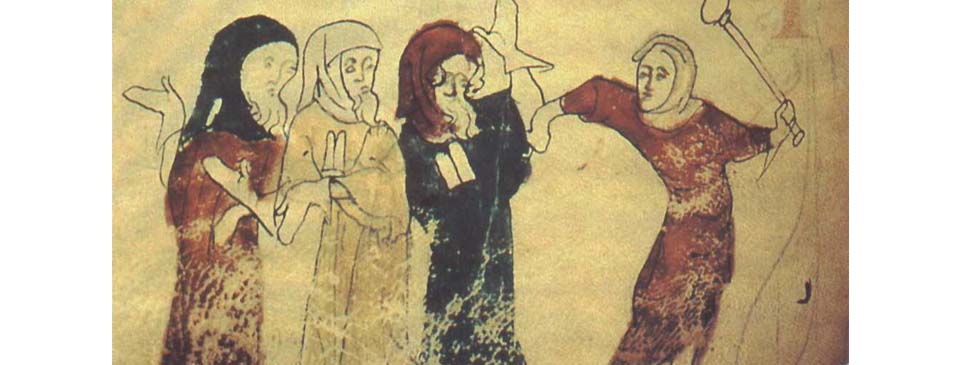The Jews of Medieval London

This illustration is from the margin of the manuscript ‘The Rochester Chronicle’, created in 1355 by the monk Edmund of Haddenham. It illustrates the expulsion of the Jews from England.
It was the beginning of the end for Jews in medieval England. Unprotected by the King they were at the mercy of the bigotry of Christians, and in some cases were caught up in attacks on all foreigners, including those from Italy and Cahors. On Palm Sunday 1263 festivities in London turned into a riot during which 400 Jews were murdered. The following year a massacre took place in the city when up to a thousand were beaten and many killed. In 1272 the London synagogue was confiscated and given over to a Christian monastery.
Prince Edward borrowed heavily from the English Jews to fund his Crusade to the Holy Land and as Edward I he had to borrow so much to fund his battles against the Welsh that he drained them dry. When they could pay no more he accused them of disloyalty and in 1275 issued the ‘Statutus de Judeismo’, which abolished their right to lend money for interest. They could earn a living as tradespeople but could not have the protection of a guild. Under pressure from the Vatican he obliged them to wear a ‘badge of shame’, a large yellow piece of cloth clearly identifying them. They were banned from leaving the country in case they took money with them. At that time there were around 3,000 Jews in England. With all the impositions placed upon them they became poor, could no longer be taxed, and were of no use to the King. In 1282 Jewish religious ceremonies were banned even in their own homes and in 1287 all Jews were imprisoned until they each paid a large ransom. In 1278 almost 700 were arrested around the country, probably on contrived charges of coin-clipping, and sent to the Tower of London where 293 were hanged and their property confiscated.
Jews were banished from Edward’s wine-growing region of Gascony in France in 1287. Finally, in July 1290, in return for Parliamentary consent to the raising of tax of £116,000 to fund his war against the Scots and the French (the largest single tax of the Middle Ages), Edward issued an edict that all Jews were to leave England by All Saints Day, 1st November or face death. They were allowed to take their cash and portable wealth, but any property and bonds (money owing to them) was confiscated by the Crown. Some went to Northern France and others to Poland where they were still legally protected. Thereafter Jews were not allowed back into England for over 400 years. England was the first country to expel its Jews but was followed by France, Spain, Portugal and others.
As a final tragedy, one of the boats commissioned to carry them from England hit a sandbar in the Thames Estuary. The captain, Henry Adrian, asked the passengers to disembark onto the sand. As the tide rose he refused to let them board again and told them to part the water like Moses. They all drowned and Adrian made off with their possessions.
Archaeological finds in the Jewish quarter around Catte (Gresham) Street have unearthed groups of pottery dated to the end of the 13th century, indicating an exodus of residents. The former stone houses of London’s Jewry became taverns or inns for people with business in the area around Guildhall.
When they first arrived in England Jews had set up their base in London. For the first century thereafter they flourished, with protection from the monarchs. Around 1140, during the reign of King Stephen, they spread further afield in England to towns such as Oxford (where they played a role in establishing the university), Winchester, York, Lincoln, Norwich, and Canterbury. At the time of their arrival London was a town largely tolerant of strangers. In the 11th century they were some of the wealthiest residents of London; 200 years later England’s Jews were subject to severe intolerance and lived in abject poverty.
For decades Jews had been the principal source of finance to the monarchs, either through loans, taxes, or confiscations. They were gradually replaced as the main lenders of money by the Knights Templar, who had arrived in the 12th century and created a base just outside the city wall at Temple. Thus, from as far back as the late 11th century England’s main financial base was London, rather than other potential cities such as Winchester. Three decades after the Jews were expelled, the Knights Templar were themselves dissolved in England by Edward II and succeeded by Flemings, and later Italians, as lenders of finance. Jews began to legally return to England in the 17th century during the time of the Commonwealth government.
Sources include: Robert Winder ‘Bloody Foreigners’; Christopher Brooke ‘London 800-1216’; John Schofield ‘London 1100-1600’; John Richardson ‘The Annals of London’; Caroline M. Barron ‘London in the Later Middle Ages’; Gustav Milne ‘The Port of Medieval London’; Lloyd P. Gartner ‘The Jewish Immigrant’; Panikos Panayi ‘Migrant City; Marcus Roberts ‘City of London Trails – Anglo Jewish History’, www.JTrails.org.uk.
Forward to London’s Jewish community of the 19th century. Part 1 – their arrival


